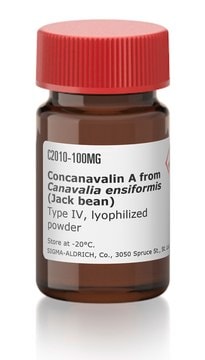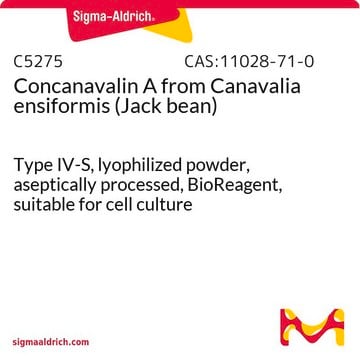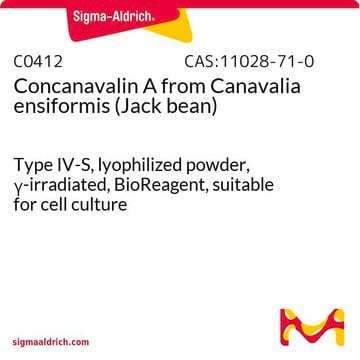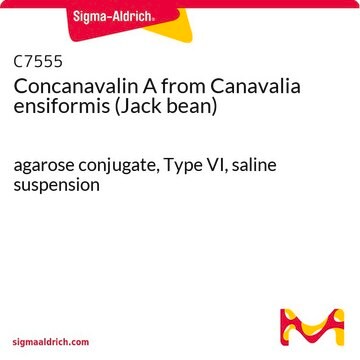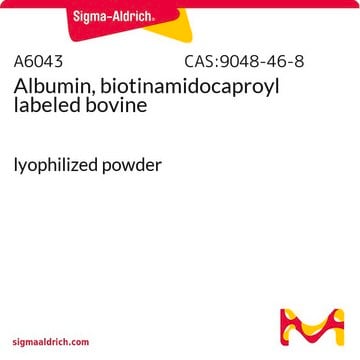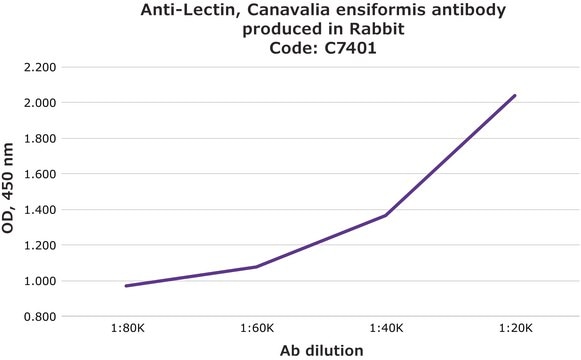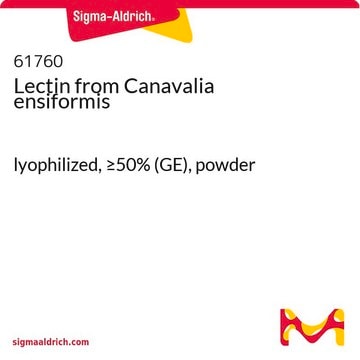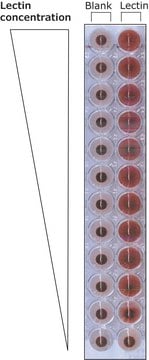C2272
Concanavalin A from Canavalia ensiformis (Jack bean)
biotin conjugate, Type IV, lyophilized powder
Synonym(s):
ConA
Sign Into View Organizational & Contract Pricing
All Photos(1)
About This Item
UNSPSC Code:
12352202
NACRES:
NA.32
Recommended Products
biological source
Canavalia ensiformis
Quality Level
conjugate
biotin conjugate
type
Type IV
form
lyophilized powder
composition
Protein, ~85% ε1%/280
extent of labeling
4-8 mol biotin per mol protein
impurities
Carbohydrate, essentially free
storage temp.
2-8°C
Looking for similar products? Visit Product Comparison Guide
General description
Concanavalin A is isolated from the from Canavalia ensiformis (Jack bean). It is a mitogenic lectin with a dome-like structures and is a tetrameric protein.
Application
Concanavalin A from Canavalia ensiformis (Jack bean) has been used:
- in the colabelling of fischer rat thyroid (FRT) epithelia(104)
- to induce autoimmune hepatitis in Cre-conditional atg7 knockout mice(105)
- to detect glycoproteins containing α-D-mannose, α-D-glucose when used with avidin or streptavidin detection system(106)
Biochem/physiol Actions
Concanavalin A (Con A) bound to glycoenzyme has wide applications and can be dissociated in the presence of high sugar levels. Con A induces hepatic inflammation. It stimulates macrophages and promotes cytokine production. Con A also exhibits anti-hepatoma effect and could be used effectively as a vaccine for treating cancer.
Con A is not blood group specific but has an affinity for terminal α-D-mannosyl and α-D-glucosyl residues. Ca2+ and Mn2+ ions are required for activity. Con A dissociates into dimers at pH 5.6 or below. Between pH 5.8 and pH 7.0, Con A exists as a tetramer; above pH 7.0 higher aggregates are formed. Con A exhibits mitogenic activity which is dependent on its degree of aggregation. Succinylation results in an active dimeric form which remains a dimer above pH 5.6.
Packaging
Package size based on protein content
Physical form
Contains sodium citrate
Analysis Note
Where reported, agglutination activity is expressed in μg/ml and is determined from serial dilutions in phosphate buffered saline, pH 6.8, containing Ca2+ and Mn2+ of a 1 mg per mL solution. This activity is the lowest concentration to agglutinate a 2% suspension of human erythrocytes after 1 hr incubation at 25 °C.
Signal Word
Warning
Hazard Statements
Precautionary Statements
Hazard Classifications
Skin Sens. 1
Storage Class Code
11 - Combustible Solids
WGK
WGK 3
Flash Point(F)
Not applicable
Flash Point(C)
Not applicable
Personal Protective Equipment
dust mask type N95 (US), Eyeshields, Gloves
Certificates of Analysis (COA)
Search for Certificates of Analysis (COA) by entering the products Lot/Batch Number. Lot and Batch Numbers can be found on a product’s label following the words ‘Lot’ or ‘Batch’.
Already Own This Product?
Find documentation for the products that you have recently purchased in the Document Library.
Customers Also Viewed
Hillary Claire Tunggal et al.
PloS one, 16(6), e0253265-e0253265 (2021-06-18)
A therapeutic vaccine that induces lasting control of HIV infection could eliminate the need for lifelong adherence to antiretroviral therapy. This study investigated a therapeutic DNA vaccine delivered with a single adjuvant or a novel combination of adjuvants to augment
Structure and function of concanavalin A
Reeke GN, et al.
Advances in Experimental Medicine and Biology, 55, 13-33 (1975)
Atg7 knockdown augments concanavalin A-induced acute hepatitis through an ROS-mediated p38/MAPK pathway
Zhuang Y, et al.
PLoS ONE, 11(3), e0149754-e0149754 (2016)
Concanavalin A: a useful ligand for glycoenzyme immobilization?a review
Saleemuddin, M and Husain Q
Enzyme and Microbial Technology, 13(4), 290-295 (1991)
Yasuhiro Fujiwara et al.
PloS one, 16(11), e0259846-e0259846 (2021-11-17)
Epigenome research has employed various methods to identify the genomic location of proteins of interest, such as transcription factors and histone modifications. A recently established method called CUT&Tag uses a Protein-A Tn5 transposase fusion protein, which cuts the genome and
Our team of scientists has experience in all areas of research including Life Science, Material Science, Chemical Synthesis, Chromatography, Analytical and many others.
Contact Technical Service